Fine-Tuning Token-Based Large Multimodal Models: What Works, What Doesn’t and What's Next
In this blog post, we explore the advancements and challenges in fine-tuning unified token-based large multimodal models, focusing on the Chameleon architecture and its fine-tuned variant, Anole. Released in 2024, these models exemplify a modern approach for integrating various data modalities through tokens, simplifying modal fusion and leveraging established techniques from large language models. The post details our research efforts to reveal what is important, what is mistaken, and what is worth exploring in future research during the fine-tuning process.
In 2024, a number of works on unified, token-based large multimodal models have emerged, including Chameleon
- Introducing the architecture of a typical unified token-based large multimodal model, Chameleon, and a fine-tuned model based on it, Anole.
- Share our intriguing findings and experiences during the fine-tuning process of this model.
- Highlight the challenges we encountered in our research and propose several questions worth exploring in the context of unified token-based multimodal models.
- Provide a clear and concise command-line guide for researchers interested in this field to quickly get started with using the model for inference or training.
We aim for our blog to be a valuable resource for both newcomers and seasoned researchers in the field. Our goal is to help newcomers quickly get up to speed while offering in-depth insights for those already engaged in this area. Additionally, we hope this work will raise awareness about unified token-based large multimodal models and promote collaboration and openness in large multimodal model research.
Background
In recent years, large multimodal models that integrate images and text have achieved significant advances in the field of artificial intelligence. These models exhibit remarkable capabilities in tasks related to cross-modal understanding and generation. By effectively combining visual and linguistic information, they adeptly handle complex tasks such as image captioning, visual question answering, and cross-modal retrieval. The primary concept behind these models is the alignment of image and text representations
Recently, unified, token-based model architectures have gained significant attention, leading to the development of innovations like Chameleon
Moreover, in this architecture, large multimodal models, similar to large language models, utilize the “next token prediction” paradigm. This allows established practices from large language models, such as inference acceleration techniques, supervised fine-tuning, and direct preference optimization, to be directly applied to these new models. Consequently, this model architecture presents numerous avenues for in-depth research and exploration.
Introduction to the architecture
In our research, we selected the Chameleon model

The current open-source version of the Chameleon model lacks the capability to generate interleaved text-image, as noted in the issues of its official GitHub repository. This limitation has dampened the enthusiasm of many researchers who were eager to explore its potential. In response, we have successfully unlocked the Chameleon model’s image generation capability without compromising its performance in language and image understanding, which we’ll elaborate on in the next section. Our enhanced version, named Anole, features the ability to create stunning images and seamlessly interweave text and image content. We have open-sourced the Anole model code, including all necessary training and fine-tuning scripts, multimodal inference scripts, and comprehensive documentation. Our code is designed to be fully compatible with the Transformers library, ensuring easy integration and accessibility for researchers working within the Transformers ecosystem.
Built upon the Chameleon model architecture, Anole excels in both understanding and generating content by seamlessly integrating text and images. A unique feature that sets Anole apart from other models supporting text-image multimodal generation is its ability to generate visual information directly using VQGAN decoding, without the need for an additional diffusion module. This model is trained natively on multimodal data, employing a token-based approach that enables intuitive modeling in discrete space, akin to large language models. Furthermore, Anole’s multimodal generation capability are entirely open-source. Table 1 below compares the Anole model with other models in the realm of text-image multimodal generation.
| Models | without Diffusion | native | token-based | fully open-sourced |
|---|---|---|---|---|
| MM-Interleaved | × | × | × | √ |
| Emu2 | × | × | × | × |
| DreamLLM | × | × | × | × |
| AnyGPT | × | × | √ | √ |
| Chameleon | √ | √ | √ | × |
| Anole | √ | √ | √ | √ |
Table 1: The characteristics of the Anole model compared to other popular multimodal models by the end of June 2024
Explorations in Token-based Large Multimodal Model Fine-Tuning
While exploring token-based fine-tuning of large multimodal models based on the Chameleon model, we encountered several research questions,which are outlined below:
Q1:How to elicit Chameleon’s image generation capability?
As mentioned earlier, the open-source Chameleon has capability limitations. Based on our analysis and practice as demonstrated in Exp 1, we ultimately activated the model’s image generation capability by fine-tuning the model’s LM_head.
Q2: Do larger foundational models possess a more powerful image generation capability?
We used the same method to stimulate the image generation capability of the 7B base model and the 30B model. On this basis, we want to explore the possibility of the existence of scaling laws in token-based large multimodal models. In Exp 2, we present a comparison of the differences in the visual modality among models of different sizes.
Q3: Since the model’s ability to generate images has been elicited by fine-tuning the LM_head, is it possible to further enhance the model’s image generation capability using this method?
In Exp 3, we attempted to further enhance the image generation quality of the model by increasing both the quantity and quality of the dataset, while using the same fine-tuning approach. During the experiment, we observed many interesting phenomena. Ultimately, our experiments revealed that merely fine-tuning a small number of parameters in the model might not significantly improve its image generation capability.
Q4: When fine-tuning token-based large multimodal model with full parameters, have we encountered any notable techniques or discoveries?
When we discovered that fine-tuning only the LM_head created a bottleneck in improving the model’s performance, we began experimenting with full parameter fine-tuning. After a series of experiments, we have shared some findings in full-parameter fine-tuning that can be used to improve training stability and enhance the model’s capability. In Exp 4, we found that data proportion plays a vital role in the fine-tuning of token-based large multimodal models. In Exp 5, we introduced Z-loss
The subsequent sections of this blog will provide a detailed presentation of our experimental methods and results. We hope that some of these research findings can address the researchers’ questions or provide them with new insights.
Fine-tuning LM_head of the model
What is LM_head and why we chose to fine-tune it exclusively
The open-source version of the Chameleon model is only capable of generating content in the text modality, which restricts its applicability in multimodal tasks. Therefore, our primary goal is to elicit the model’s ability to generate images, enabling it to process and generate visual content.
In our preliminary tests assessing the model’s capabilities, we found that the Chameleon model demonstrates an understanding of multimodality by effectively using the text modality to describe given images. This suggests that, within an early-fusion large multimodal model, the model’s visual modality encoder and Transformer layers are operating correctly.
Based on these observations, we hypothesize that the LM_head layer, located after the Transformer layers, could be the key factor restricting its ability to generate in a multimodal fashion. The LM_head layer is a linear layer that maps the hidden states produced by the Transformer into vocabulary logits. Its weights constitute a two-dimensional matrix, as illustrated in Figure 2. Tokens numbered from 4 to 8197 are designated as image tokens, while the remaining tokens represent the text modality. Obviously, the values in this matrix at the image token are noticeably abnormal, as if noise has been added.

Exp 1-Eliciting image generation capability of Chameleon
We focused our efforts on fine-tuning the model by freezing all parameters except for those in the LM_head. Specifically, we aimed to preserve the integrity of the text modality while enhancing the model’s image generation capability. To achieve this, we only fine-tuned the parameters associated with image tokens within the LM_head, as indicated by the red section of the matrix mentioned earlier.
We meticulously selected 6,000 images from the LAION-5B art dataset
We also attempted to fine-tune the Chameleon model with full parameters under the same configuration. However, the fine-tuned model only produced striped images and failed to fully restore its capability for image generation. This outcome underscores the advantages of our method. A schematic of our approach and examples of the generated images are displayed in Figure 3 and Figure 4 below.


Exp 2-Exploring the Scaling Law Phenomenon in token-based multimodal models
Our earlier experiments focused on the Chameleon-7B model, and we extended our investigation to the Chameleon-30B model by utilizing the same fine-tuning configurations to explore its image generation capability. When comparing images produced by the 30B and 7B models using identical prompts, the 30B model delivers noticeably superior quality, marked by richer details. As demonstrated in Figure 5, images generated by the larger model capture more elements from the prompts, such as the sunset in the first image and the rising smoke in the second. Additionally, the larger model tends to create more polished images, as evidenced by the depiction of the coffee cup in the third image. These observations suggest that early-fusion large multimodal models with auto-regressive architectures might exhibit a phenomenon akin to the scaling law, a concept extensively validated in the realm of large language models. This hypothesis presents an intriguing avenue for further in-depth research by scholars in the field. We also conducted a simple image generation test comparing the 30B and 7B models under the same training conditions. On the Geneval benchmark
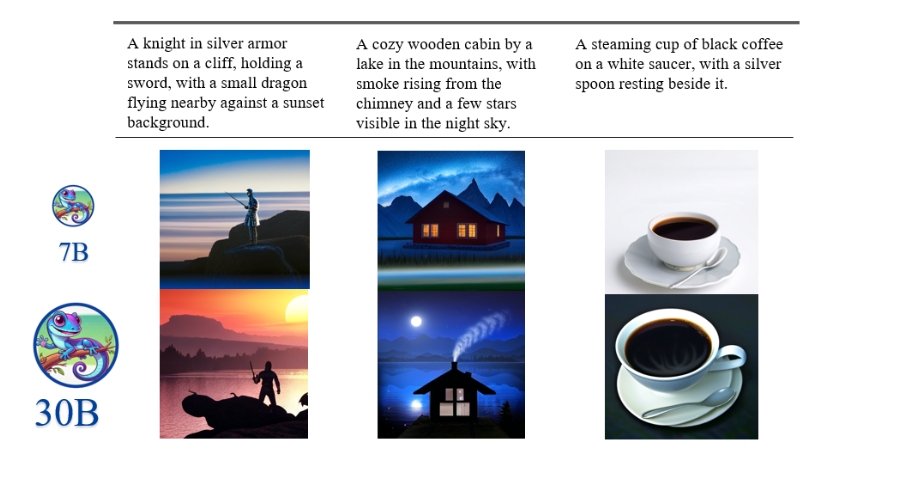
Exp 3-Attempting to further improve image generation capability of the model by fine-tuning LM_head
After initially enhancing the model’s image generation capability with 6,000 images, we moved on to fine-tune a few parameters in the LM_head layer. Subsequently, we expanded the dataset to include 30,000 high-quality images for further refinement. Despite this additional fine-tuning, we observed no noticeable improvement in the quality of the images produced by the model. As illustrated in Figure 6, with sufficient training, the model is capable of generating visually appealing images. However, it continues to struggle with effectively following instructions. For instance, when we aimed to generate a city nightscape that included sidewalks and pedestrians in the second image, the final result failed to depict any pedestrians.

Furthermore, our observations indicate that insufficiently trained models compromise the completeness of generated images. As depicted in Figure 7, a model lacking adequate training often produces images with horizontal disruptions. For instance, in the fifth image, where the prompt was “Under the bright sun, dinosaurs strolling in Times Square, with people taking photos and traffic passing by,” the generated image clearly displays a dividing line in the middle. Two similarly colored dinosaurs are positioned above and below this line. This issue may stem from the raster scan order of image token generation.

We are striving not only to expand the dataset’s size but also to enhance its quality. To further boost the model’s performance, we incorporated an additional 100,000 images from the JourneyDB
Despite a substantial increase in dataset size and diversity, the model’s performance did not meet expectations. Persistent issues, such as difficulty in accurately following instructions and generating low-quality images, remain unresolved.
As demonstrated in Figure 8, the image quality produced by the fine-tuned Anole model has shown some improvement. The model generates more accurately detailed faces and better-shaped waterfalls in the examples. However, it still does not fully meet all the requirements specified in the instructions, such as depicting ‘holding a guitar’ in the first figure. More concerning, for the high-quality data from JourneyDB (as seen on the right side of the image below), the fine-tuned model did not exhibit any significant enhancements in generating images from the training set.
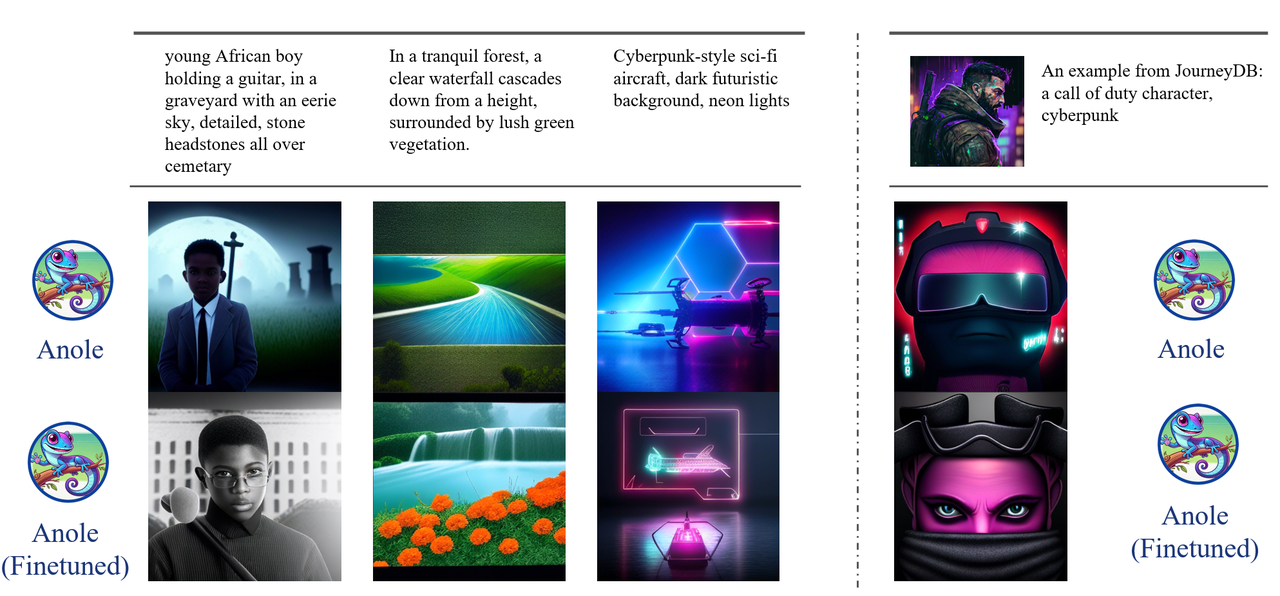
During the fine-tuning process of the LM_head layer of our model, we observed notable results. The model demonstrated an ability to generate detailed images for specific categories, such as animals. However, it showed weaknesses when generating images for certain other categories. We speculate that the frozen model backbone contains a substantial amount of multimodal knowledge, and fine-tuning the LM_head can only elicit this capability without introducing new knowledge. This explains why, after fine-tuning on various datasets, the model consistently performs well on specific categories but struggles with others, including categories present in the fine-tuning dataset.
Thus, we conducted an experiment where we fine-tuned the LM_head layer of the Chameleon model, which originally lacked image generation capability. Using only four facial images for training until convergence, the model produced remarkable outcomes, as shown in Figure 9. Despite the training dataset containing solely human faces, the fine-tuned model was capable of generating images of camels, wine glasses, dogs, and valleys—categories that were not included in the training data.
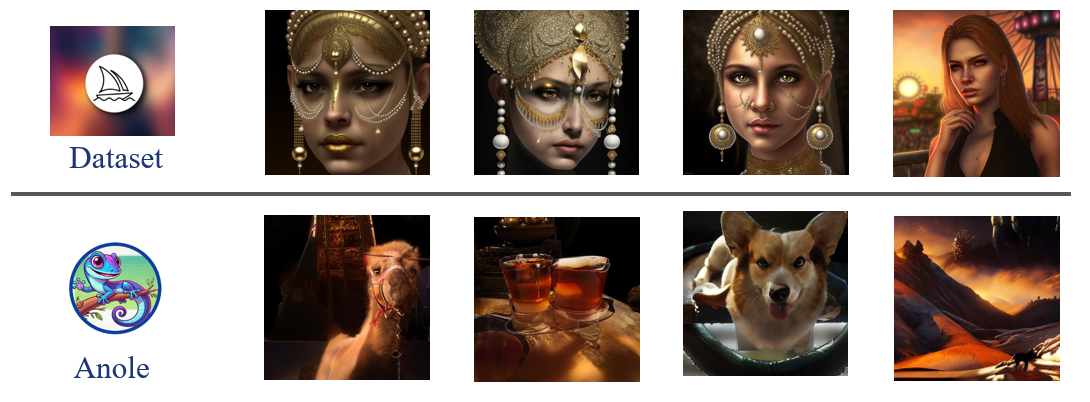
We hypothesize that during pre-training, the unmodified Transformer layers had already accumulated a substantial amount of multimodal knowledge. Fine-tuning the LM_head layer serves to elicit the model’s existing image generation capability, but it is challenging to introduce new knowledge or concepts through this layer alone. Based on this insight, we conducted further experiments, attempting full parameter fine-tuning of the model. Our goal was to more comprehensively adjust the internal weight of the model, thereby enhancing its ability for cross-modal generation and knowledge acquisition.
Fine-tuning full parameters of the model
Advantages and new challenges of full parameter tuning
Our objective is to refine the model’s internal weights through full parameter tuning, enabling it to assimilate new knowledge and improve its performance in multimodal generation tasks. Nevertheless, a significant challenge of full parameter tuning is ensuring that the model retains its original capabilities to the greatest extent possible as it integrates new knowledge. This challenge is particularly pronounced in multimodal scenarios, where the model must consistently perform well in tasks involving image generation, text generation, and those that combine both. An unstable tuning process could lead to diminished performance in certain tasks, which underscores the importance of achieving stability in the process.
To tackle this issue, we experimented with adjusting the proportions of the training data to ensure optimal task performance across different modalities. Additionally, we implemented the Z-loss method
Exp 4-Exploring the impact of different data proportions on fine-tuning
During the full parameter fine-tuning of multimodal models, we discovered that using only single-modal data (such as pure text or pure images) significantly weakens the model’s generalization ability across other modalities. This results in bad performance on cross-modal tasks. To maintain the model’s competency across various modalities, it is crucial to include a diverse mix of multiple modalities in the training data. This should encompass tasks like text-to-text, text-to-image, and image-to-text, among others. Such mixed-modal training enables the model to better understand and leverage the interactions between different modalities, thereby enhancing its performance across a broad spectrum of tasks.
In our experiments, we attempted to fine-tune the Anole model, which has multimodal capabilities, using purely text data. As a result, the fine-tuned model was restricted to performing text-to-text tasks and lost its proficiency in other multimodal functionalities. Conversely, when the model was fine-tuned with a combination of text-to-text and text-to-image tasks, it maintained its capabilities in text-to-text, text-to-image, and image-to-text tasks. However, it was no longer able to generate interleaved text-image content.
When deciding whether to incorporate interleaved text-image data in training, it’s important to consider the specific requirements of your task. If the task involves generating interleaved content, such as comics or image captions, including this type of data can significantly enhance the model’s performance in producing mixed content. Conversely, if interleaved generation is unnecessary for your application, you can forego including this data. It’s worth noting that recent research
To scientifically determine the optimal ratio of multimodal training data, further exploration is necessary. This is a critical issue that significantly influences model performance. When designing data composition, it is essential to consider not only the specific task requirements but also the potential negative effects of various data types. By assessing the impact of different data types on the model’s capabilities, one can ensure both effective generalization and robust task performance.
Exp 5-Exploring the impact of Z-loss on training stability
We have introduced the Z-loss mentioned from the Chameleon paper to address the logit shift issue. The Z-loss is used to regularize the denominator Z of the softmax function (1). The final form of the loss function is as follows.
\[\sigma(x)_i = \frac{e^{x_i}}{Z}, \quad Z = \sum_{i} e^{x_i} \quad\quad (1)\] \[\mathcal{L}_{\text{total}} = \mathcal{L}_{\text{cross_entropy}} + 10^{-5} \log^{2} Z \quad\quad (2)\]Recent research claims that Z-loss helps the training loss to converge
Nevertheless, simply adding Z-loss did not effectively enhance the performance of the fine-tuned model in our experiment. As shown in Figure 10, after fine-tuning with 10,000 text-to-text and text-to-image mixed sample in a 1:1 ratio, the model based on Anole with Z-loss did not show a significant decrease in the loss function, nor did it lead to noticeable improvements in image generation quality. The reasons for this experimental failure might be that we did not find more effective or suitable fine-tuning methods, such as precise hyperparameter tuning, insufficient training data, or mismatched data types. Additionally, the Chameleon architecture itself may exhibit instability during training, making it challenging to train effectively.
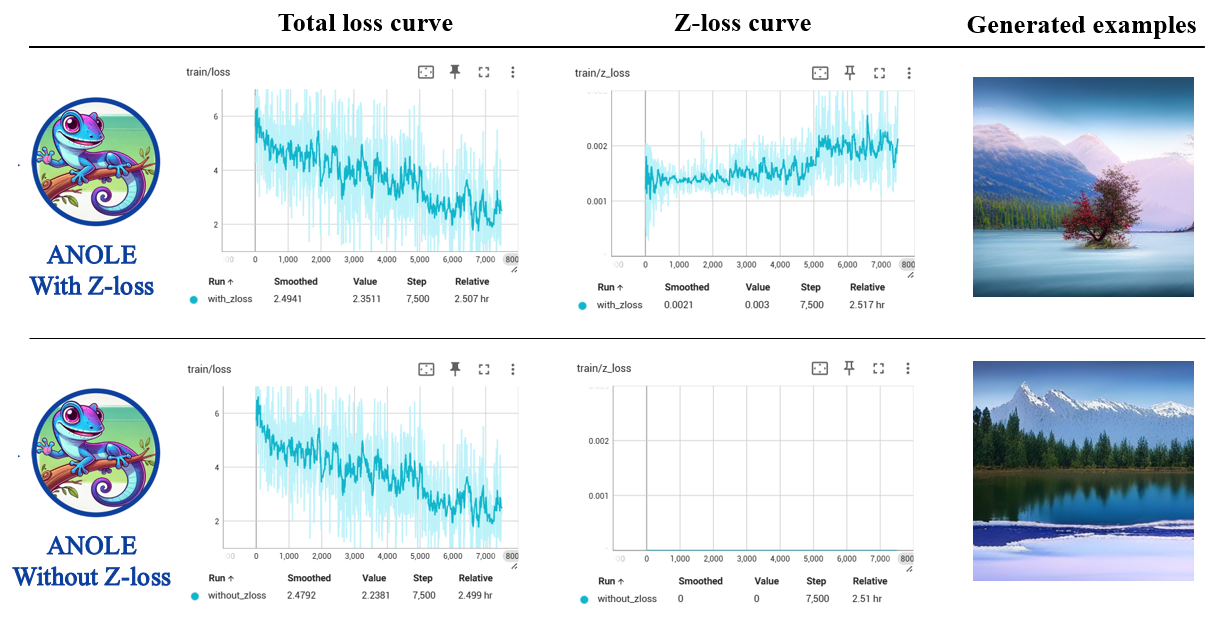
In summary, maintaining training stability during the full parameter fine-tuning process is a challenging and worthwhile area of exploration for a large multimodal model utilizing an early fusion architecture. Coordinating the fusion of multimodal information during fine-tuning and optimizing training strategies to ensure model stability is not only crucial for enhancing the performance of multimodal models but also an important research direction for advancing this field further. Continuing to explore and find more effective fine-tuning methods in future work will have a significant impact on evolution and application of large multimodal models.
Exp 6-Exploring improving a model’s image generation capability by enhancing the loss function
In our experiments focused on enhancing image generation capability, we discovered that fine-tuning only the LM_head layer does not lead to significant improvements in image quality, image-text alignment accuracy, or consistency with the style of images in the training dataset. The underlying reason is that when solely the LM_head layer is fine-tuned, the crucial parameters of the model’s Transformer backbone remain unchanged, limiting the model’s flexibility and adaptability. This restriction hinders the model’s ability to fully explore and optimize its multimodal generation capabilities, ultimately creating a bottleneck in enhancing image quality. To overcome this issue, we proceeded to conduct full parameter fine-tuning on the Anole model.
During full parameter fine-tuning with text-to-image data, we encounter an unexpected challenge: while using standard cross-entropy loss, the training loss decreases significantly, but the quality of generated images deteriorates, and there’s a risk of mode collapse. As illustrated in Figure 11, the training loss drops dramatically when compared to fine-tuning only the LM_head, going from 5 to 5e-3. However, this improvement in loss does not translate to better image quality. We hypothesize that the cross-entropy loss function may be ill-suited for image generation tasks. Due to its local nature, it can lead to numerous local minima on the loss surface, making the optimization process prone to getting stuck. This limitation hinders the quality of the output images. Consequently, we aim to enhance the model fine-tuning process by developing a more suitable loss function for training, ultimately seeking to improve the quality of generated images.
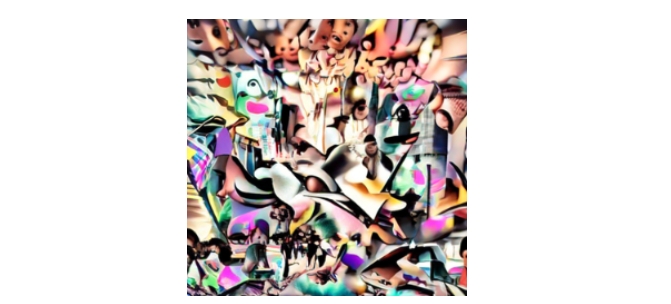
To address the aforementioned issues and improve image generation quality, we propose a method based on reconstruction loss. During training, we map the entire generated image into the feature space of VQGAN codebook features. We then use the codebook features of the original images from the training set as supervision labels for supervised learning. This approach allows the model to optimize the loss function not by focusing only on local information, but by making adjustments and optimizations from a global perspective for the entire image generation. Such a holistic method better captures the overall structure and details of the image, thereby enhancing the quality and consistency of the generated images. The specific training process is illustrated in Figure 12, which includes the complete process from feature extraction to loss calculation, ensuring that the model can effectively optimize each generation step during training. The final loss function we use is \(\mathcal{L} = \alpha \mathcal{L}_{\text{reconstruction}} + \mathcal{L}_{\text{cross_entropy}}\)
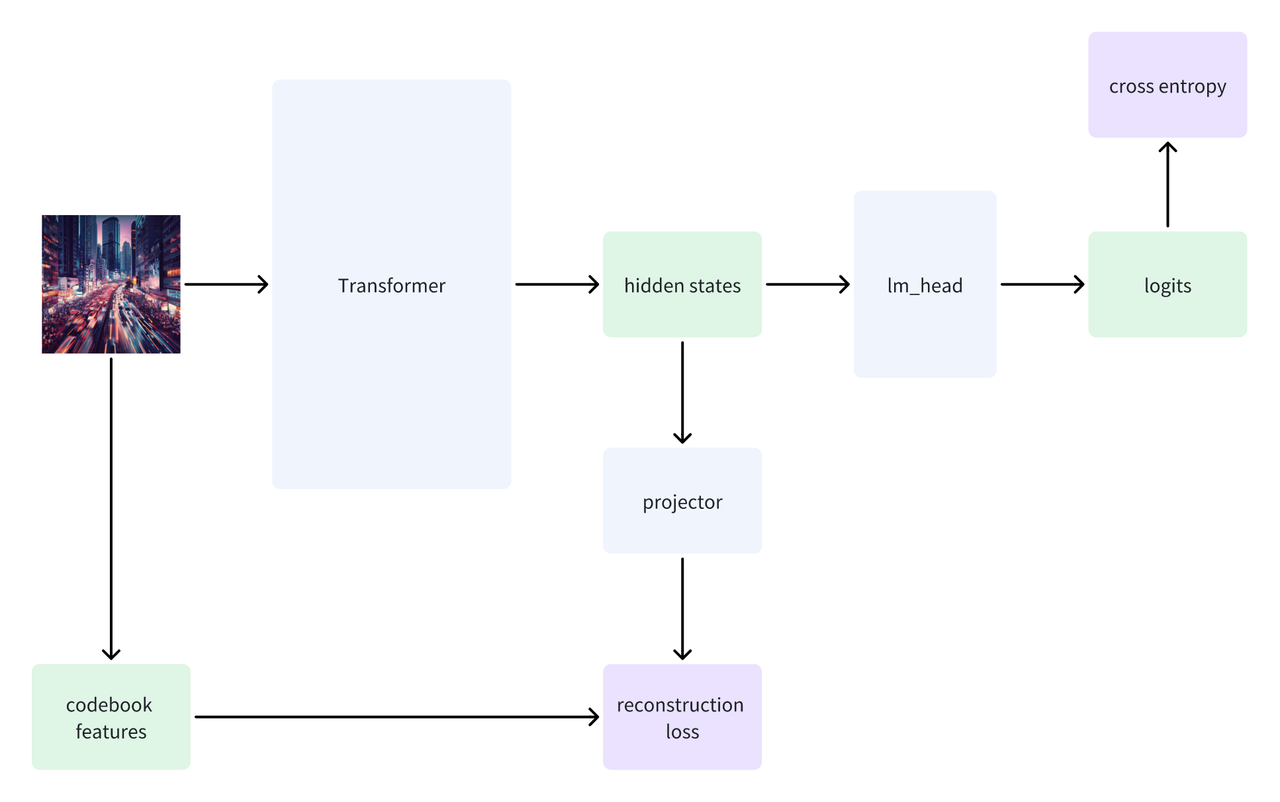
We conducted experiments using a small dataset, which consists of 2,000 images. A smaller dataset is more likely to increase the risk of overfitting during full parameter fine-tuning of the model. In this setting, conducting experiments makes it easier to observe the effect of adding this loss. The results, as illustrated in Figure 13, show that as the weight of the reconstruction loss increases, the value rapidly decreases, while the cross-entropy loss experiences a slight increase. When the weight of the reconstruction loss reaches 0.5, the generated images effectively avoid mode collapse, displaying more diverse and stable image quality. However, if the reconstruction loss weight becomes too high, the images begin to appear overly smooth, resulting in a loss of detail and an overall decline in quality. Therefore, the experiments indicate that setting the reconstruction loss weight within an optimal range can effectively enhance the quality of image generation by the model, avoiding the issues that arise from relying solely on cross-entropy loss.
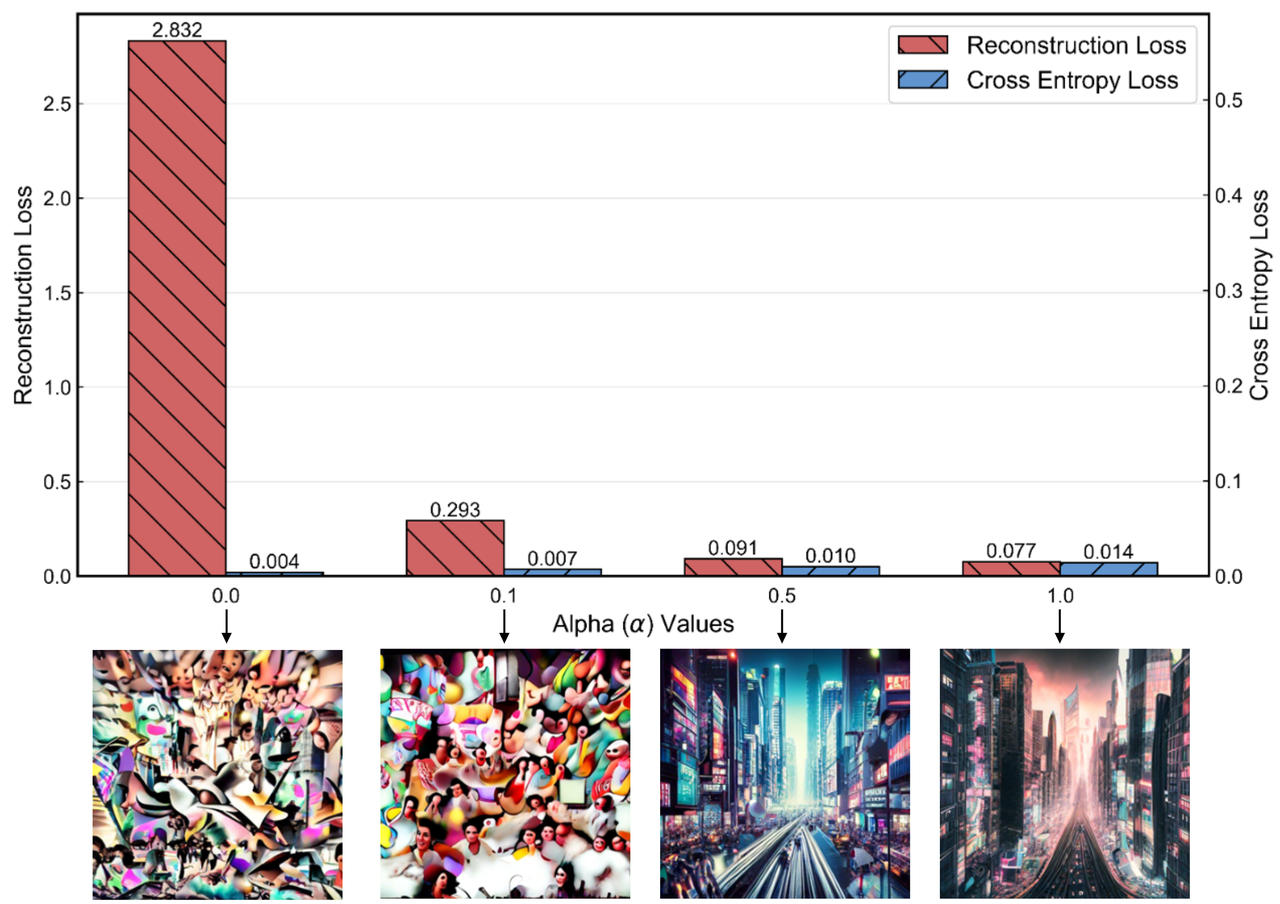
Currently, we are further experimenting with the specific values of the weights and planning to expand the dataset to examine whether improving the loss function can significantly enhance image generation performance during full parameter fine-tuning. Through full-parameter fine-tuning, our 7B model achieved a score of over 0.39 on the Geneval benchmark, demonstrating image generation capabilities comparable to those of the unreleased Chameleon 7B model. Future experiments will also focus on the impact of different loss weight combinations on generation quality, aiming to identify the optimal parameter configurations that work well across various tasks and datasets. Improving the loss function is also a worthwhile area to explore in multimodal generation.
Overall, although all modalities are encoded into tokens in a token-based architecture, we can optimize the training process by applying additional loss functions to specific modalities that are more difficult to train. To optimize image generation, some studies have explored new loss functions
Quick start
To enable researchers to more quickly start working with token-based unified multimodal large models, we have open-sourced the weights of the Anole model, along with inference scripts, training scripts, and the dataset for fine-tuning. With the following code, researchers can quickly install, use our model, and perform inference and training.
First, download our repository and install the relevant environment.
#Download repo and install environments
git clone ...
cd anole-hf
bash install.sh
Next, download the Hugging Face weights for the model. You can choose to download either the Chameleon or Anole weights. Due to double-blind reviews, we do not provide the weight download links here. Now, you can use the model for inference. The code supports input and output in any modality, whether image or text. Below is an example.
###text to image
python text-image.py -i Instruction -b Batch_size -s Save_dir
###Multimodal in & multimodal out
python interleaved_generation -i Instruction -s Save_dir
#the instruction for mulitimodal is a json file, e.g.
#[
# {
# "type": "text",
# "content": "What can I bake with this? Give me the full recipe and show me an image with the final dish. <image>"
# },
# {
# "type": "image",
# "content": ["./banana.png"]
# }
#]
Our code also supports both few parameters fine-tuning and full parameter fine-tuning as mentioned in the blog. You can run the command below:
cd training
#set constants such as ckpt path in constants_training.py
#train.py is the code for full parameters fine-tuning
#finetune.py is the code for fine-tuning model's LM head
#You can determine which file to run based on the model size and the type of fine-tuning.
#An example to fine-tuning 30b model's full parameters:
CUDA_VISIBLE_DEVICES=4,5 torchrun --nproc_per_node=2 train_30b.py
In addition, you can fine-tune using your own collected dataset.
cd training
#You need to organize the data format in advance.
python data_tokenization.py
Conclusion
In conclusion, this blog post introduced the Chameleon architecture and the fine-tuned anole model, highlighting it as a prominent example of the popular token-based unified large multimodal model architecture. We also discussed our findings and the challenges we faced during the fine-tuning process. Additionally, we are pleased to announce that we have open-sourced both the weights and code for our fine-tuned Anole model. We hope that by sharing these resources, we can assist fellow researchers in advancing the study of unified large multimodal models, and collectively stimulate progress in this exciting field.